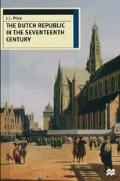Abstract
It is generally accepted that the northern provinces of the Netherlands underwent an economic transformation which began sometime in the late fifteenth or early sixteenth century and took off about a century later. This process was most marked in the maritime provinces, with Holland — of course — in the lead, but even the land provinces were also profoundly affected by the changes in the country as a whole. That economic developments on this scale inevitably had significant social consequences is not in dispute; what historians are not agreed on is the nature of the society which was created by these developments. By the late seventeenth century it seems clear that the first completely capitalist economy in history had emerged in the Republic but, oddly enough, there seems to be a near-consensus among historians that what would seem to be the indispensable social corollary of capitalism — the bourgeoisie — did not and indeed could not exist at this time in any meaningful sense.1 This debate aside, the question still remains whether the economic changes were far-reaching enough to produce new social formations and, if so, whether such a transformation was limited to the maritime provinces. It is clear that different regions of the Republic were affected in very different ways by the economic developments of the sixteenth and seventeenth centuries, and it may well be that some social groups were more profoundly affected than others, but whether a new type of society emerged is more difficult to determine.
Preview
Unable to display preview. Download preview PDF.
Notes
A useful introduction to a complex and often confusing controversy can be found in Peter Burke, The language of orders in early modernEurope’, in M. L. Bush (ed.), Social Orders and Social Classes in Europe since 1500 (London, 1992 ), pp. 1–12.
See Jan de Vries, The Dutch Rural Economy in the Golden Age ( New Haven, CT, 1974 ).
Jan Bieleman, Boeren op het Drentse zand 1600–1910 (Wageningen, 1987), pp. 665–9.
De Vries and Van der Woude, The First Modern Economy pp. 507–21; and the evidence for North Holland in C.M. Lesger, Hoorn als stedelijk knooppunt. Stedensystemen tijdens de late middeleeuwen en vroegmoderne tijd (Hilversum, 1990), appendix F.
J.L. van Zanden, The Rise and Decline of Holland’s Economy. Merchant Capitalism and the Labour Market (Manchester, 1993), pp. 39–40, 116.
See Diederik Aten, Als het gewelt comt…’ Politiek en economie in Holland benoorden het If 1500–1800 (Hilversum, 1995), pp. 232–63, for examples from the Northern Quarter of Holland.
E. Taverne, In’t land van belofte: in de nieue stadt. Ideaal en werkelijkheid van de stadsuitleg in de Republiek 1580–1680 (Marssen, 1978), ch. 5.
J.L. Price, ‘A State Dedicated to War? The Dutch Republic in the Seventeenth Century’, in The Medieval Military Revolution, ed. Andrew Ayton and J.L. Price (London, 1995 ), p. 189.
The most recent assessment of Dutch army size is in H.L. Zwitzer, ‘De Militie van den Staet’. Het leger van de Republiek der Verenigde Nederlanden (Amsterdam, 1991), bijlage 1.
Jaap R. Bruijn, The Dutch Navy of the Seventeenth and Eighteenth Centuries ( Columbia, SC, 1993 ), p. 131.
For interesting contributions to this subject in English, see Els Kloek et al. (eds): Women of the Golden Age. An International Debate on Women in Seventeenth-century Holland, England and Italy (Hilversum, 1994).
See the general coverage in O. Hufton, The Prospect before Her. A History of Women in Western Europe, vol.1,1500–1800 (London, 1995 ).
Lotte van de Pol, Het Amsterdams hoerdom. Prostitutie in de zeventiende en achttiende eeuw (Amsterdam, 1996).
Willem de Blécourt, Termen van toverij (Nijmegen, 1990) includes frequent references to the bewitching of milk and the like.
See the tentative conclusions in Els Kloek, Wie hij zij, man of wijf (Hilversum, 1990), pp. 57–66, 74–7.
A. Th. van Deursen, Plain Lives in a Golden Age (Cambridge, 1991), pp. 79.
For an overview, see J.L. Price, The Dutch Nobility in the Seventeenth and Eighteenth Centuries’, in H.M. Scott (ed.), The European Nobilities in the Seventeenth and Eighteenth Centuries, vol. 1: Western Europe (London, 1995 ), pp. 82–113.
H.F.K. van Nierop, The Nobility of Holland: from Knights to Regents 1500–1650 (Cambridge, 1993).
Author information
Authors and Affiliations
Copyright information
© 1998 J. L. Price
About this chapter
Cite this chapter
Price, J.L. (1998). A Bourgeois Society?. In: The Dutch Republic in the Seventeenth Century. European History in Perspective. Palgrave, London. https://doi.org/10.1007/978-1-349-26994-5_6
Download citation
DOI: https://doi.org/10.1007/978-1-349-26994-5_6
Publisher Name: Palgrave, London
Print ISBN: 978-0-333-61379-5
Online ISBN: 978-1-349-26994-5
eBook Packages: Palgrave History CollectionHistory (R0)

